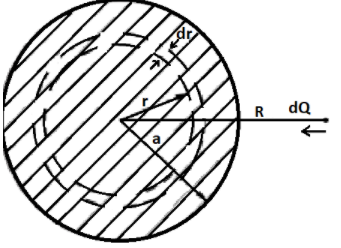
The potential energy of a uniform circular disc of radius R and carrying charge density $\sigma $ is
A. \[\dfrac{2}{3}\dfrac{\pi \sigma _{{}}^{2}{{R}^{3}}}{\varepsilon_0}\]
B. \[\dfrac{1}{3}\dfrac{\pi \sigma _{{}}^{2}{{R}^{3}}}{\varepsilon_0}\]
C. \[\dfrac{\pi \sigma _{{}}^{2}{{R}^{3}}}{\varepsilon_0}\]
D. Can Not be determined
Answer
570.6k+ views
Hint: While solving this question, try to find out the expression for the potential energy of a disc with unit area. After that integrate that express to find out the potential of the disc with the required radius/area. Electrical potential energy, or Electrostatic potential energy, is a potential energy (measured in joules) that arises from conservative Coulomb forces and is correlated with the configuration of a certain set of point charges within a given device. An object can provide electrical potential energy from two main elements: its own electrical charge and its relative location to other electrically charged objects.
Formula used:
For solving this question, we will be using the formula for the potential energy, i.e
${{U}_{E}}=k\dfrac{{{q}_{1}}{{q}_{2}}}{r}$
Complete answer:
Area of the disc = $\pi {{R}^{2}}$
So, total charge on the disc will be,
$q=\sigma \pi {{R}^{2}}$
Now, let us assume a small area dA

So,
$dA=2\pi rdr$
So, we have
$\begin{align}
& dq=\sigma dA \\
& dq=2\sigma \pi rdr \\
\end{align}$
Now,
$\begin{align}
& dU=\dfrac{kqdq}{r} \\
& U=\int{dU=\int{\dfrac{kqdq}{r}}} \\
\end{align}$
$\begin{align}
& \Rightarrow U=2{{\pi }^{2}}K{{\sigma }^{2}}\int\limits_{0}^{R}{{{r}^{2}}dr} \\
& \Rightarrow U=\dfrac{2{{\pi }^{2}}K{{\sigma }^{2}}{{R}^{3}}}{3} \\
\end{align}$
Now,
Since,
$\Rightarrow K=\dfrac{1}{4\pi {{\varepsilon }_{o}}}$
We have,
$\begin{align}
& \Rightarrow U=\dfrac{2{{\pi }^{2}}{{\sigma }^{2}}{{R}^{3}}}{3}\dfrac{1}{4\pi {{\varepsilon }_{o}}} \\
& \Rightarrow U=\dfrac{\pi \sigma _{{}}^{2}{{R}^{3}}}{3{{\varepsilon }_{o}}} \\
\end{align}$
So, the potential energy of a uniform circular disc of radius R and carrying charge density $\sigma $ will be $U=\dfrac{\pi \sigma _{{}}^{2}{{R}^{3}}}{3{{\varepsilon }_{o}}}$.
i.e., Option – C is the correct answer.
Note:
The term "electric potential energy" is used to characterise potential energy in systems with time-variant electrical fields, while the term "electrostatic potential energy" is used to characterise potential energy in systems with time-invariant electrical fields. The term potential energy was invented by the Scottish engineer and physicist William Rankine of the 19th century, although it is related to the Greek philosopher Aristotle 's idea of potentiality.
Formula used:
For solving this question, we will be using the formula for the potential energy, i.e
${{U}_{E}}=k\dfrac{{{q}_{1}}{{q}_{2}}}{r}$
Complete answer:
Area of the disc = $\pi {{R}^{2}}$
So, total charge on the disc will be,
$q=\sigma \pi {{R}^{2}}$
Now, let us assume a small area dA

So,
$dA=2\pi rdr$
So, we have
$\begin{align}
& dq=\sigma dA \\
& dq=2\sigma \pi rdr \\
\end{align}$
Now,
$\begin{align}
& dU=\dfrac{kqdq}{r} \\
& U=\int{dU=\int{\dfrac{kqdq}{r}}} \\
\end{align}$
$\begin{align}
& \Rightarrow U=2{{\pi }^{2}}K{{\sigma }^{2}}\int\limits_{0}^{R}{{{r}^{2}}dr} \\
& \Rightarrow U=\dfrac{2{{\pi }^{2}}K{{\sigma }^{2}}{{R}^{3}}}{3} \\
\end{align}$
Now,
Since,
$\Rightarrow K=\dfrac{1}{4\pi {{\varepsilon }_{o}}}$
We have,
$\begin{align}
& \Rightarrow U=\dfrac{2{{\pi }^{2}}{{\sigma }^{2}}{{R}^{3}}}{3}\dfrac{1}{4\pi {{\varepsilon }_{o}}} \\
& \Rightarrow U=\dfrac{\pi \sigma _{{}}^{2}{{R}^{3}}}{3{{\varepsilon }_{o}}} \\
\end{align}$
So, the potential energy of a uniform circular disc of radius R and carrying charge density $\sigma $ will be $U=\dfrac{\pi \sigma _{{}}^{2}{{R}^{3}}}{3{{\varepsilon }_{o}}}$.
i.e., Option – C is the correct answer.
Note:
The term "electric potential energy" is used to characterise potential energy in systems with time-variant electrical fields, while the term "electrostatic potential energy" is used to characterise potential energy in systems with time-invariant electrical fields. The term potential energy was invented by the Scottish engineer and physicist William Rankine of the 19th century, although it is related to the Greek philosopher Aristotle 's idea of potentiality.
Recently Updated Pages
Master Class 11 Economics: Engaging Questions & Answers for Success

Master Class 11 English: Engaging Questions & Answers for Success

Master Class 11 Social Science: Engaging Questions & Answers for Success

Master Class 11 Biology: Engaging Questions & Answers for Success

Class 11 Question and Answer - Your Ultimate Solutions Guide

Master Class 11 Business Studies: Engaging Questions & Answers for Success

Trending doubts
10 examples of friction in our daily life

One Metric ton is equal to kg A 10000 B 1000 C 100 class 11 physics CBSE

Difference Between Prokaryotic Cells and Eukaryotic Cells

1 Quintal is equal to a 110 kg b 10 kg c 100kg d 1000 class 11 physics CBSE

State the laws of reflection of light

Explain zero factorial class 11 maths CBSE




